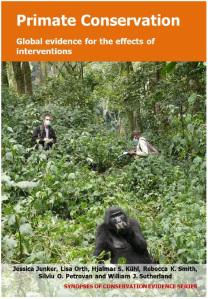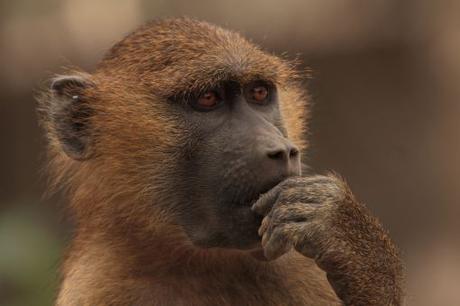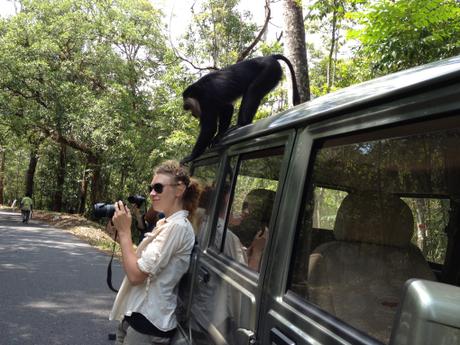
Concrete jungle. A Barbary macaque sits in a human-dominated landscape in Gibraltar. Photo: Silviu Petrovan
Saving primates is a complicated business. Primates are intelligent, social animals that have complex needs. They come into conflict with humans when they raid rubbish bins and crops, chew power cables, and in some cases become aggressive towards people.
Humans, however, have the upper hand. While 60% of non-human primate species are threatened, humans grow in numbers and power, building roads through forests, hunting and trapping primates, and replacing their habitat with farms and houses.
To help primatologists choose the most effective conservation approaches to resolve these problems, researchers in the Conservation Evidence project teamed up with primate researchers to produce a global database on the effectiveness of primate conservation solutions. This free database, which can also be downloaded as a single pdf, summarizes the evidence for 162 conservation interventions — actions that conservationists might take to conserve primates. The data come from searches of over 170 conservation journals and newsletters, and each study is summarized in a single paragraph in plain English, making it possible for conservationists without access to scientific journals to read the key findings.

Further emphasizing the importance of involving local communities, implementing no-hunting community policies or traditional hunting bans also appeared helpful in boosting primate numbers. In other places, a more traditional approach of using rangers to protect primates has proved a winning strategy. Training rangers, providing them with arms, and increasing ranger patrols all worked to protect primates from poachers. Identifying the circumstances in which community led approaches or ranger patrols work will be key to implementing the most appropriate response to each conservation challenge.
However, for some interventions, the effectiveness was extremely difficult to determine due to the paucity of data; for 59% of interventions, the researchers could find no studies at all that quantitatively tested their effectiveness. Interpretation of other interventions was hampered by the fact that in many studies, many interventions were implemented at the same time, making it difficult to assess the impacts of each intervention separately.
Testing conservation interventions can be difficult; it diverts money away from the ‘doing’ of conservation, and often there are good reasons for implementing multiple interventions at the same time to try and help a threatened species. However, without good quality research, interventions can be worse than ineffective. The primate synopsis found, for example, that reintroduction programmes varied from being highly successful, with most individuals surviving and reproducing, to exercises in which the majority of released animals died.

Unsure what to test? Check out ConservationEvaluation.org. Image of a Guinea baboon Papio papio, Abuko, Gambia. Photo: Silviu Petrovan
Clearly, there is an urgent need to find the best ways to do conservation interventions such as reintroductions. If all primate conservationists test a single intervention every year or two, and publish the results, the database will become increasingly useful to everyone.
The Conservation Evidence team recommend to primate conservation programmes that they check out the free PRISM toolkit online when planning projects. This gives practical guidance on how to choose what to evaluate, how to test interventions on everything from awareness raising to habitat management, and how to share data for maximum impact. Single interventions can be tested even when a range of conservation actions are going to be taken, for example by staggering the timing at which each is done.
The authors of the Primate synopsis also identified topics for which testing interventions is especially important. Small, nocturnal species, and primates in South America and Asia, were under-represented in the global database of studies. There were also few studies on ways to mitigate the impacts of mining, which is a concern as mining activities are expanding in primate habitats in many locations around the world.

Lion-tailed macaque (right) researches Claire Wordley (left) in Valparai, India — the Conservation Evidence team call for more research the other way round, due to the scarcity of studies on interventions for Asian primates.
Finally, any of the interventions for which there is currently no evidence would be great starting points for any research project — and brilliant PhD topics. The Conservation Evidence team hope to update the Primate synopsis every few years. If the global community of academics and NGOs pulls together to fill the evidence gaps, this can be an excellent living resource of the best ways to save primates long into the future.
—
Claire Wordley, Conservation Evidence, University of Cambridge

